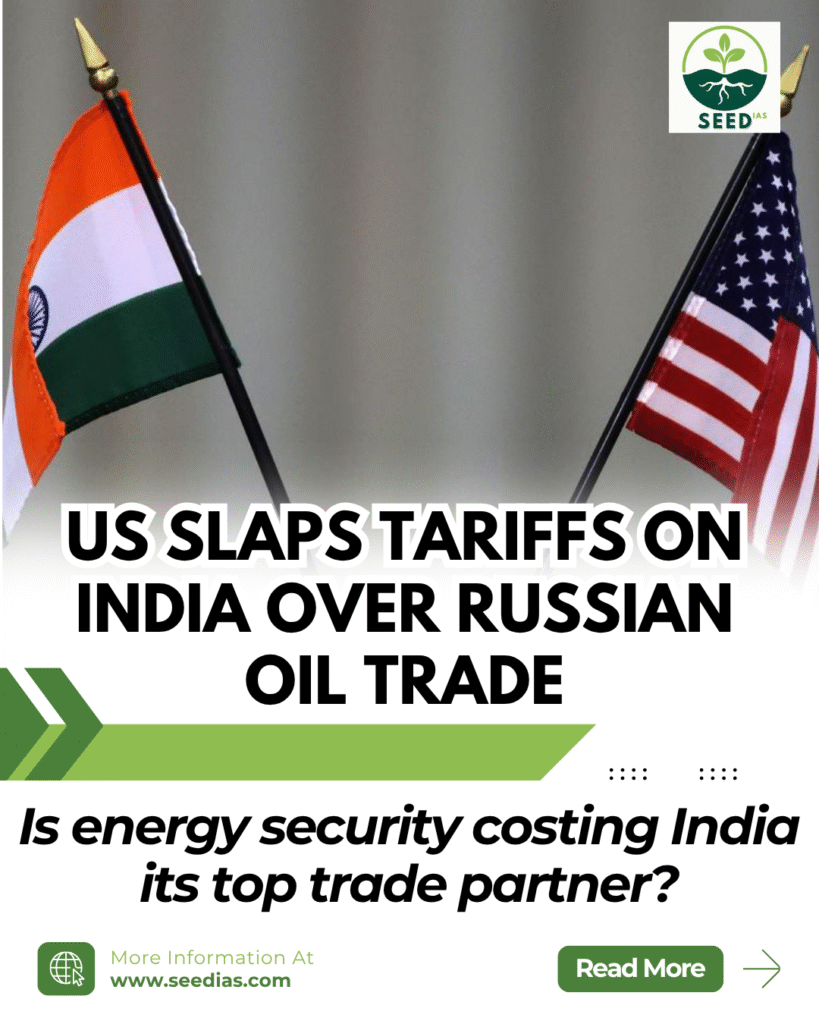Why in NEWS
The United States has imposed additional tariffs on Indian exports, citing New Delhi’s ongoing oil imports from Russia. India, alongside Brazil, is now among the most heavily tariffed nations by the US. This move strains bilateral trade ties and raises questions about global double standards.
Key Concepts and Terms
| Term | Explanation |
|---|---|
| Tariff | A tax imposed on imports or exports between countries, used to regulate trade and protect domestic industries. |
| Bilateral Trade Agreement | A trade pact between two countries to reduce tariffs and enhance trade flow. |
| Non-Tariff Barriers | Trade restrictions that don’t involve tariffs, such as quotas, regulations, or licensing. |
| Energy Security | The uninterrupted availability of energy sources at an affordable price. |
| Trade Deficit | When a country’s imports exceed its exports, leading to a negative trade balance. |
News Summary
India is under pressure from the US over its continued purchase of discounted Russian oil, which the US views as a loophole to its sanctions on Russia. In response, the US raised tariffs on Indian goods, impacting approximately $87 billion worth of exports annually. This decision comes despite India’s increase in US imports and record bilateral trade in recent years. India criticized the move, highlighting the hypocrisy of Western nations like the EU, which continue importing Russian energy. India has defended its oil strategy as essential for its national interest and energy security, driven by market factors and the need to fuel a population of over 1.4 billion.
Factors Leading to the Tariff Hike
| Factor | Explanation |
|---|---|
| Stalled Trade Talks | India and the US failed to finalize a trade agreement due to disagreements over agriculture and dairy liberalization. |
| High Tariffs in India | The US raised concerns about India’s high tariffs and barriers in pharmaceuticals, electronics, and agriculture. |
| Russian Oil & Defense Imports | India’s energy and defense ties with Russia irked the US amid sanctions. |
| Trade Deficit | The US has a $45 billion trade deficit with India, fueling trade imbalance concerns. |
| Peer Pressure | India is being compared to countries like Vietnam and Japan, which have secured favorable US trade deals. |
Key Stats on India-US Trade Relations
| Indicator | Value |
|---|---|
| Total Trade (2024–25) | $131.84 billion (India’s largest trading partner) |
| India’s Agri Imports from US | ↑49.1% to $1,693.2 million |
| India’s Exports to US | ↑24.1% to $3,472.7 million |
| FDI from US (2023–24) | $4.99 billion |
| Russian Crude Oil Buyers (2022–25) | China: 47%, India: 38%, EU: 6% |
Implications of US Tariffs
| Area | Impact |
|---|---|
| Export Disruption | Tariffs will impact $87 billion worth of exports, including electronics, textiles, jewellery, and pharma. |
| Job Losses | Labor-intensive sectors like garments and gems may face layoffs. |
| GDP Forecast Cut | ADB revised India’s FY26 GDP forecast from 6.7% to 6.5%. |
| Loss of Market Share | Buyers may shift to cheaper alternatives from Vietnam, Indonesia, etc. |
| Stock Market Reaction | 40+ export-heavy Indian firms saw sharp stock declines. |
| Trade Relations Strain | Reduces hopes for preferential treatment and worsens diplomatic trust. |
Solutions to Minimize the Damage
| Solution | Details |
|---|---|
| Speed Up Trade Talks | Schedule additional rounds to finalize a balanced trade deal with US. |
| Export Diversification | Expand FTAs with EU, Gulf, EFTA, East Asia to reduce US dependence. |
| Enhance Competitiveness | Promote product innovation, value-addition, and quality to remain globally attractive. |
| Support Affected Sectors | Provide export credit, duty refunds, and subsidies to impacted industries. |
| Energy Strategy Rebalance | Diversify oil imports away from Russia; invest in renewable energy resilience. |
In a Nutshell
Mnemonic: T.R.A.D.E.S.
- Tariff pressure due to Russian oil purchases
- Resilient Indian defense of energy policy
- Agreements stalled despite growing trade
- Deep impact on exports, jobs, and GDP
- EU hypocrisy in Russian energy imports exposed
- Strategic shift needed in trade and energy policy
Prelims Practice Questions
- Which of the following sectors is most likely to be affected by recent US tariffs on Indian goods?
a) Petroleum refining
b) Electronics and textiles
c) Real estate
d) Fisheries - Why has the US cited India’s oil imports from Russia as a concern?
a) It affects global oil prices
b) It undermines US-led sanctions on Russia
c) India does not share oil with allies
d) India is the largest oil producer - Which country had the highest share of Russian crude oil imports between 2022 and 2025?
a) EU
b) China
c) India
d) Turkiye
Mains Questions
- Critically examine the implications of the US tariff hike on India’s economy and diplomatic ties.
15 Marks - How can India safeguard its trade interests while balancing its strategic autonomy in global geopolitics? 10 Marks
Prelims Answers and Explanations
| Q No. | Answer | Explanation |
|---|---|---|
| 1 | b | Sectors like electronics, textiles, gems, and jewellery are most exposed to US tariffs. |
| 2 | b | India’s continued oil imports from Russia are seen as undercutting US sanctions. |
| 3 | b | China was the largest buyer (47%) of Russian crude oil during the period. |
















